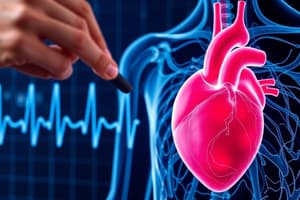Podcast
Questions and Answers
What are abnormal pulsations in the pericardium that you should inspect for during assessment?
What are abnormal pulsations in the pericardium that you should inspect for during assessment?
Abnormal pulsations include lifts and heaves.
How does palpation complement inspection during a pericardial assessment?
How does palpation complement inspection during a pericardial assessment?
Palpation helps detect the presence of abnormal pulsations that may not be visible.
What might the presence of lifts or heaves indicate about a patient's heart condition?
What might the presence of lifts or heaves indicate about a patient's heart condition?
They may indicate conditions such as hypertrophy or heart failure.
Why is it important to assess for abnormal pulsations in the pericardium?
Why is it important to assess for abnormal pulsations in the pericardium?
What steps should a clinician take when inspecting the pericardium for lifts or heaves?
What steps should a clinician take when inspecting the pericardium for lifts or heaves?
What is Systole in the context of heart function?
What is Systole in the context of heart function?
How is Diastole defined in relation to heart activity?
How is Diastole defined in relation to heart activity?
What are the differences between S3 and S4 heart sounds in children and older adults respectively?
What are the differences between S3 and S4 heart sounds in children and older adults respectively?
What physiological process occurs during the Systole phase of the cardiac cycle?
What physiological process occurs during the Systole phase of the cardiac cycle?
Why is it important to understand the phases of the cardiac cycle, specifically Systole and Diastole?
Why is it important to understand the phases of the cardiac cycle, specifically Systole and Diastole?
What is a bruit and what sound does it describe?
What is a bruit and what sound does it describe?
In which population is bruit commonly developed?
In which population is bruit commonly developed?
List two conditions that can lead to the development of a bruit.
List two conditions that can lead to the development of a bruit.
How does hyperthyroidism contribute to the formation of a bruit?
How does hyperthyroidism contribute to the formation of a bruit?
What does the presence of a bruit indicate regarding blood flow?
What does the presence of a bruit indicate regarding blood flow?
What anatomical line is referenced for percussion in the given procedure?
What anatomical line is referenced for percussion in the given procedure?
In which intercostal space should percussion begin according to the procedure?
In which intercostal space should percussion begin according to the procedure?
Describe the direction of percussion during the procedure.
Describe the direction of percussion during the procedure.
What is the significance of using percussion in this context?
What is the significance of using percussion in this context?
Who is the author recognized for the described percussion technique?
Who is the author recognized for the described percussion technique?
Why are external neck veins normally distended and visible when a person is lying down?
Why are external neck veins normally distended and visible when a person is lying down?
Explain how gravity affects external neck vein visibility in an upright position.
Explain how gravity affects external neck vein visibility in an upright position.
What physiological changes occur in the venous system when a person changes from lying down to standing?
What physiological changes occur in the venous system when a person changes from lying down to standing?
Discuss how body position can impact venous pressure in the neck.
Discuss how body position can impact venous pressure in the neck.
Why is it important to observe the visibility of neck veins in a clinical setting?
Why is it important to observe the visibility of neck veins in a clinical setting?
Flashcards are hidden until you start studying
Study Notes
Heart Assessment: Inspection and Palpation
- Inspect and palpate the pericardium for abnormal pulsations, such as lifts or heaves.
- Abnormal pulsations may indicate underlying cardiac issues.
Cardiovascular Examination Techniques
- Percussion:
- Percuss along the anterior axillary line towards the sternum at the fifth intercostal space.
- S3 heart sound may be present in children and young adults, while S4 is commonly found in older adults.
Cardiac Cycle: Systole and Diastole
- Systole:
- Period during which the ventricles contract, pumping blood into the arteries.
- Diastole:
- Period in which the ventricles relax and fill with blood.
Bruit: Definition and Causes
- Bruit: A blowing or swishing sound, indicative of vascular issues.
- Commonly develops in older adults.
- Causes include:
- Narrowing of the arterial lumen.
- Anemia.
- Hyperthyroidism, which increases cardiac output.
Observations of Veins
- External neck veins are usually distended and visible when a person is lying down but not when standing.
- This observation helps in assessing hemodynamic status.
Studying That Suits You
Use AI to generate personalized quizzes and flashcards to suit your learning preferences.




